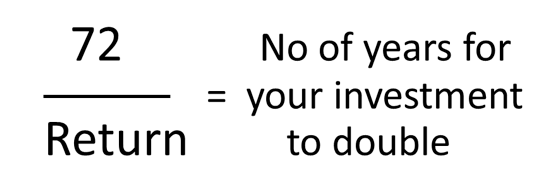Investment Golden Rules
Sometimes the best advice is the simplest advice.
Investment golden rules of thumb are useful to many investors who won’t have time for complete and in-depth investment planning.
Have you heard people asking these questions ?
- How do I compare return on my investment ?
- What is time frame to double my investment ?
- Is this investment consistent with my most important goals in life?
- How much should I withdraw from the investment ?
- Are there simple guide or investment rules to follow ?

The four most dangerous words in investing are: this time it’s different. Sir John Templeton
Risk Vs Return
Risk
Simply put, risks is the chance that your investment’s actual return may be different than expected and it includes the possibility of losing some or all of the original capital as well.
The investment risks can be broadly grouped into the categories :
- Credit Risk – bond issuer defaults in paying interest or maturity value
- Currency Risk – fluctuation in price of one currency against other currencies
- Inflation Risk – inflation reduce the purchasing power of cash flow
- Interest Rate Risk – instrument like bond decline in value as a result of a rise in interest rates
- Market Risk – market conditions that affect all securities in the same manner
- Liquidity Risk – unable to sell an investment as and when desired due to limited opportunities
Risk is usually measured using Standard deviation or Variance.
Return
Return, which is usually quoted as percentage ; is either the gain or loss of a investment in a particular period. Gain in investment comes in the form of income like dividends or capital appreciation of the asset.
Return is usually measured as Holding Period Return(HPR).

Investment Golden Rules part 1
Rule 1 – Save and Invest 10% of Your Earned Income.
Before spending your money, follow the principle to “pay yourself first.” Take 10% of your income and invest for the long term, such as a retirement account.
By using “Paying yourself first”, implying that you’re paying to build equity in yourself with every income your received. This money which you’re saving is then kept as a capital, which you can invest in a either low risk interest bearing assets. Thus, over time you are building wealth not only through your regular deposits of 10% of your income, but also through the interest being earned on the money you’ve already made.
Rule 2 – “110 Minus Your Age”
This rule suggest the percentage of equity or shares allocation in your investment portfolio.
As an individual investor, you need incentive to take risk. That incentive with stocks is – over the long run it give higher returns compared to your saving accounts.
The younger you are, the bigger the percentage of your capital can be invested in equity. For a investor of age 30, you may allocate up to 80% in equity funds.
Rule 3 – 10%, 5%, 3% Rule
This is a handy rule that states that you can expect a nominal return of 10% from equities, 5% return from bonds and 3% return on highly liquid fixed deposit accounts. Of course, this is a an average return over the long term.
If you are being conservative in nature, then you may opt for more achievable return of 8% for equities, 5% for bonds, 3% for fixed deposits.

Investment Golden Rules part 2
Rule 4 – Long Term Inflation Average Is 4%
Due to lowering demand, deflation is one of the major concerns afflicting the economy. However, over time, inflation will work against your investments.
When pursuing long-term financial goals, from education savings for your children to retirement planning, it’s important to consider the real rate of return, which is determined by figuring in the effects of inflation.
What is means it your fixed deposit account give you a return of 3%, after taking average inflation of 4% ; your real rate of return of investment is -1%. Hence your fixed deposit account are not on par with the inflation.
Rule 5 – Rule of 72
The Rule of 72 states that the number of years for your investment to double. You can divide the number 72 by the investment return you are getting to see how long it would take for your investment to double.
Take the fixed deposit return of 3% for example, it will take the sum of 10,000 to double to 20,000 in 24 years.
However, for a good performing equity fund, it should take 8 years to double the same amount of 10,000 into 20,000. About 1/3 of the time !
Rule 6 – 30 x Annual expenses
If you are investing to build your long term retirement fund, then this rule will be applicable.
You need 30 times of your annual expenses for a comfortable retirement. Considering if you retire at normal age of 60 and can live up for another 20-25 years, factoring inflation, it comes to about 30x of your expenses. So, if your annual expenses at 100,000 / year, you will need about 3 million for retirement.
Of course there is another approach to retirement savings says that you’ll need to save about 20 x your gross annual income to retire. However, this is a rough estimate as it focuses on income and not expenses, and expenses are what matter.

16 Investment Rules
This recommended reading strengthens your investment knowledge prior to actual investing.
